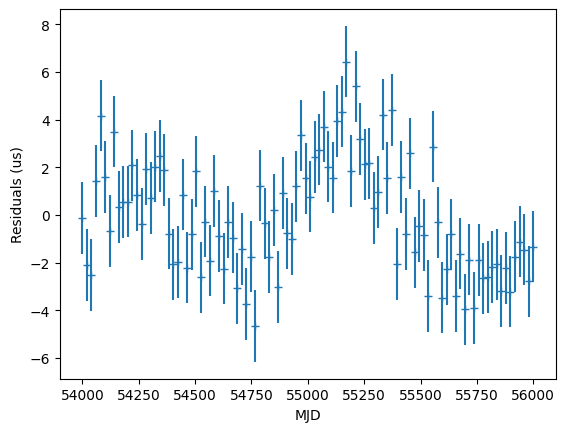This Jupyter notebook can be downloaded from simulation_example.ipynb, or viewed as a python script at simulation_example.py.
Demonstrate TOA simulation using PINT
[1]:
from pint.models import get_model
from pint.simulation import (
make_fake_toas_uniform,
make_fake_toas_fromtim,
)
from pint.residuals import Residuals, WidebandTOAResiduals
from pint.logging import setup as setup_log
from pint import dmu
from pint.config import examplefile
import numpy as np
import matplotlib.pyplot as plt
import astropy.units as u
import io
# Turn logging level to warnings and above
setup_log(level="WARNING")
[1]:
1
Basic example
[2]:
# First, let us create a simple model from which we will simulate TOAs.
m = get_model(
io.StringIO(
"""
RAJ 05:00:00
DECJ 20:00:00
PEPOCH 55000
F0 100
F1 -1e-14
DM 15
PHOFF 0
EFAC tel gbt 1.5
TZRMJD 55000
TZRFRQ 1400
TZRSITE gbt
EPHEM DE440
CLOCK TT(BIPM2019)
UNITS TDB
"""
)
)
[3]:
# The simplest type of simulation we can do is narrowband TOAs with uniformly
# spaced epochs (one TOA per epoch) with a single frequency and equal TOA uncertainties.
tsim = make_fake_toas_uniform(
model=m,
startMJD=54000,
endMJD=56000,
ntoas=100,
freq=1400 * u.MHz,
obs="gbt",
error=1 * u.us,
include_bipm=True,
include_gps=True,
)
[4]:
# Let us try plotting the residuals
res = Residuals(tsim, m)
plt.errorbar(
tsim.get_mjds(),
res.time_resids.to_value("us"),
res.get_data_error().to_value("us"),
marker="+",
ls="",
)
plt.xlabel("MJD")
plt.ylabel("Residuals (us)")
plt.show()
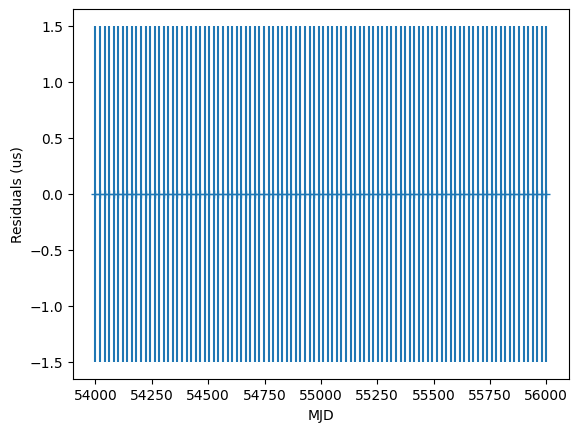
Here we see that the TOAs don’t have the expected white noise. The noise should be 1.5 us, including the EFAC. The noise can be included by using the add_noise option.
[5]:
tsim = make_fake_toas_uniform(
model=m,
startMJD=54000,
endMJD=56000,
ntoas=100,
freq=1400 * u.MHz,
obs="gbt",
error=1 * u.us,
include_bipm=True,
include_gps=True,
add_noise=True,
)
[6]:
res = Residuals(tsim, m)
plt.errorbar(
tsim.get_mjds(),
res.time_resids.to_value("us"),
res.get_data_error().to_value("us"),
marker="+",
ls="",
)
plt.xlabel("MJD")
plt.ylabel("Residuals (us)")
plt.show()
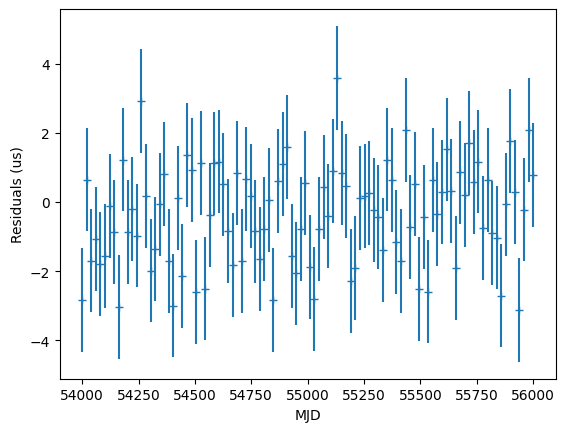
The same thing can be achieved in the command line using the following command:
$ zima --startMJD 54000 --ntoa 100 --duration 2000 --obs gbt --freq 1400 --error 1 --addnoise test.par test.tim
Multiple frequency example
Multiple frequency TOAs can be simulated by passing an array of frequencies into the freq parameter.
[7]:
freqs = np.linspace(1000, 2000, 4) * u.MHz
tsim = make_fake_toas_uniform(
model=m,
startMJD=54000,
endMJD=56000,
ntoas=100,
freq=freqs,
obs="gbt",
error=1 * u.us,
include_bipm=True,
include_gps=True,
add_noise=True,
)
[8]:
res = Residuals(tsim, m)
plt.subplot(211)
plt.errorbar(
tsim.get_mjds(),
res.time_resids.to_value("us"),
res.get_data_error().to_value("us"),
marker="+",
ls="",
)
plt.xlabel("MJD")
plt.ylabel("Residuals (us)")
plt.subplot(212)
plt.errorbar(
tsim.get_freqs(),
res.time_resids.to_value("us"),
res.get_data_error().to_value("us"),
marker="+",
ls="",
)
plt.xlabel("Freq (MHz)")
plt.ylabel("Residuals (us)")
plt.show()
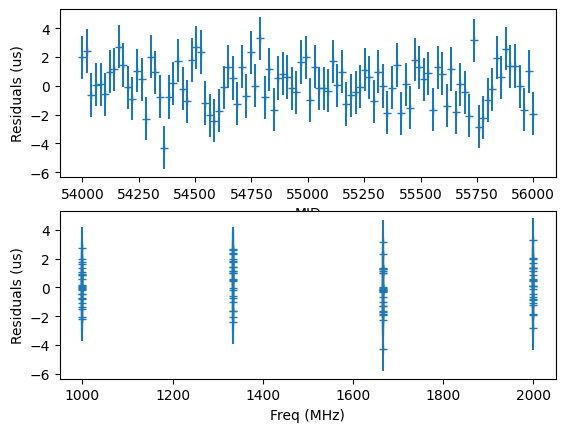
We see that the frequencies are distributed amongst epochs such that there is only one TOA per epoch. To distribute the TOAs such that each epoch contains all frequencies, use the multi_freqs_in_epoch option. Note that this option doesn’t change the total number of TOAs.
[9]:
freqs = np.linspace(1000, 2000, 4) * u.MHz
tsim = make_fake_toas_uniform(
model=m,
startMJD=54000,
endMJD=56000,
ntoas=100,
freq=freqs,
obs="gbt",
error=1 * u.us,
include_bipm=True,
include_gps=True,
add_noise=True,
multi_freqs_in_epoch=True,
)
[10]:
res = Residuals(tsim, m)
plt.subplot(211)
plt.errorbar(
tsim.get_mjds(),
res.time_resids.to_value("us"),
res.get_data_error().to_value("us"),
marker="+",
ls="",
)
plt.xlabel("MJD")
plt.ylabel("Residuals (us)")
plt.subplot(212)
plt.errorbar(
tsim.get_freqs(),
res.time_resids.to_value("us"),
res.get_data_error().to_value("us"),
marker="+",
ls="",
)
plt.xlabel("Freq(MHz)")
plt.ylabel("Residuals (us)")
plt.show()
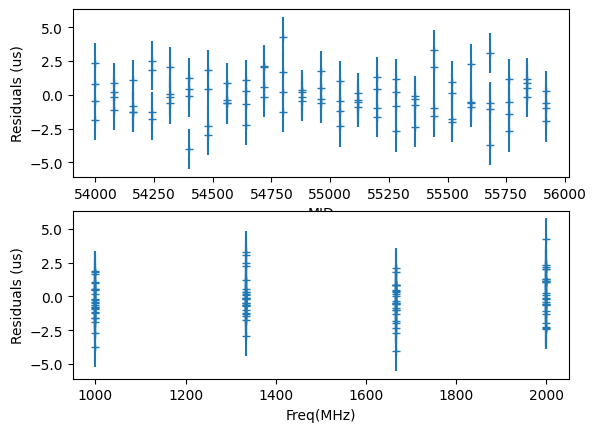
The same thing can be achieved in the command line using the following command:
$ zima --startMJD 54000 --ntoa 100 --duration 2000 --obs gbt --freq 1000 1333.33 1666.67 2000 --error 1 --addnoise --multifreq test.par test.tim
Wideband TOA simulation example
Wideband TOAs can be simulated using the wideband option. The white noise RMS for the wideband DMs is controlled using the wideband_dm_error parameter.
[13]:
m2 = get_model(
io.StringIO(
"""
RAJ 05:00:00
DECJ 20:00:00
PEPOCH 55000
F0 100
F1 -1e-14
DMEPOCH 55000
DM 15
DM1 1
DM2 0.5
PHOFF 0
EFAC tel gbt 1.5
TZRMJD 55000
TZRFRQ 1400
TZRSITE gbt
EPHEM DE440
CLOCK TT(BIPM2019)
UNITS TDB
"""
)
)
tsim = make_fake_toas_uniform(
model=m2,
startMJD=54000,
endMJD=56000,
ntoas=100,
freq=1400 * u.MHz,
obs="gbt",
error=1 * u.us,
include_bipm=True,
include_gps=True,
wideband=True,
wideband_dm_error=1e-5 * dmu,
add_noise=True,
)
[14]:
res = WidebandTOAResiduals(tsim, m2)
plt.subplot(211)
plt.errorbar(
tsim.get_mjds(),
res.toa.time_resids.to_value("us"),
res.toa.get_data_error().to_value("us"),
marker="+",
ls="",
)
plt.xlabel("MJD")
plt.ylabel("Residuals (us)")
plt.subplot(212)
plt.errorbar(
tsim.get_mjds(),
tsim.get_dms().to_value(dmu),
res.dm.get_data_error().to_value(dmu),
marker="+",
ls="",
)
plt.xlabel("MJD")
plt.ylabel("Wideband DM (dmu)")
plt.show()
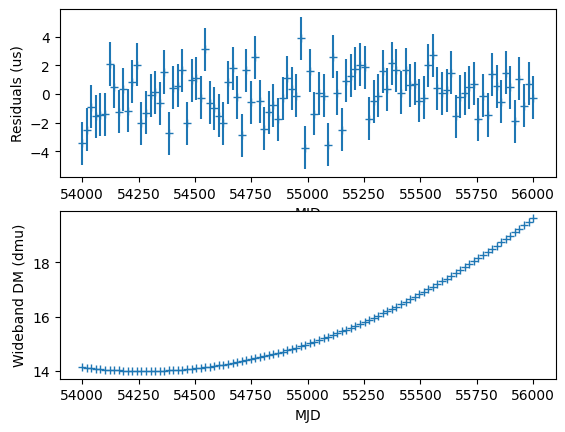
The same thing can be achieved in the command line using the following command:
::
$ zima –startMJD 54000 –ntoa 100 –duration 2000 –obs gbt –freq 1400 –error 1 –addnoise –wideband –dmerror 1e-5 test.par test.tim
Simulating TOAs based on a tim file
TOAs can be simulated to match the configuration of an existing tim file (e.g. epochs, TOA uncertainties, frequencies, flags, etc.) using the make_fake_toas_fromtim function. This also works with wideband tim files.
[15]:
tsim = make_fake_toas_fromtim(
timfile=examplefile("B1855+09_NANOGrav_9yv1.tim"),
model=m,
add_noise=True,
)
[16]:
res = Residuals(tsim, m)
plt.errorbar(
tsim.get_mjds(),
res.time_resids.to_value("us"),
res.get_data_error().to_value("us"),
marker="+",
ls="",
)
plt.xlabel("MJD")
plt.ylabel("Residuals (us)")
plt.show()
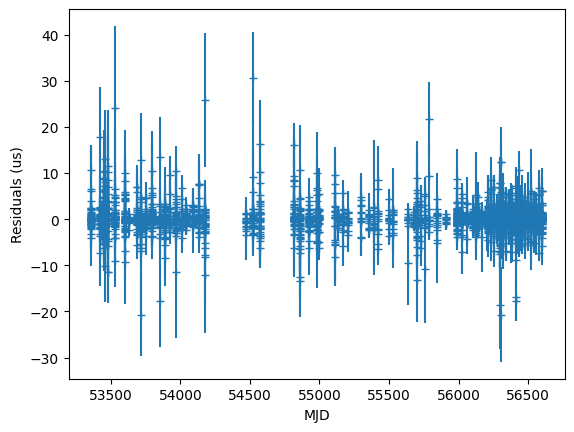
The same thing can be achieved in the command line using the following command:
::
$ zima –inputtim B1855+09_NANOGrav_9yv1.tim –addnoise test.par test.tim
